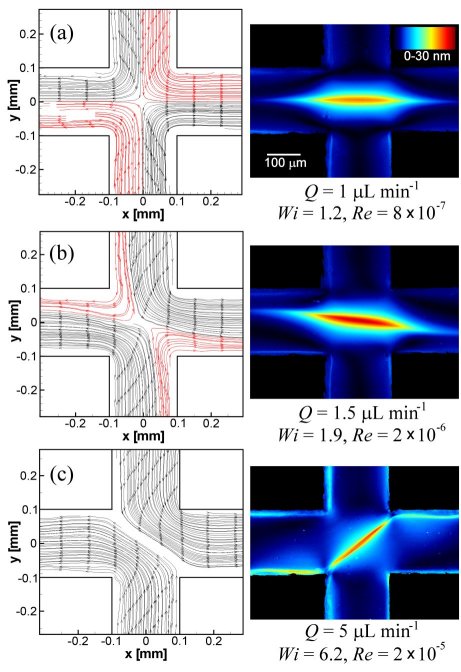Wormlike
micelles are elongated semi-flexible
aggregates resulting from the self-assembly of amphiphilic molecules in
solution. In the semi-dilute and concentrated regimes, wormlike
micellar solutions are entangled and exhibit viscoelasticity in a way
similar
to polymer solutions, with a typical relaxation time (λ)
on the order of milliseconds to seconds.
However, a significant difference between wormlike micelles and
conventional
polymers with covalently bonded back-bone chains is their ability to
break and
reform dynamically, resulting in unusual stress relaxation behaviour
and allowing the
rheological properties of the solutions to recover subsequent
to degradation in strong flows. In addition the
physical properties of the micelles (e.g. contour length, persistence
length and relaxation time) are extremely sensitive to factors
including surfactant concentration, ionic strength and temperature, which
allows an exquisite control over the bulk fluid rheological properties. The
resulting unique properties of these fluids
have led to their use in a wide range of applications in including
jetting and spraying,
turbulent drag
reduction, enhanced oil
recovery. Such processes involve complex flow fields with
strongly extensional components, which can cause large and rapid
deformation of
the fluid microstructure. The resulting stretching and alignment of
micelles
leads to a range of poorly understood phenomena including flow-induced
chain
scission and structure formation,
and elastic
instabilities.
We have been using our microfluidic cross-slot device to study the
nature of purely elastic flow instabilities in wormlike micellar
solutions in this well-defined extensional flow with a view
understanding and optimizing industrial uses of these fascinating
fluids.

Related Publications
P. E. Arratia, C. C. Thomas, J. Diorio and J. P. Gollub, Elastic Instabilities of Polymer Solutions in Cross-Channel Flow. Physical Review Letters, 2006, 96, 144502.
R. J. Poole, M. A. Alves and P. J. Oliveira, Purely elastic flow asymmetries. Physical Review Letters, 2007, 99, 164503.
J. A. Pathak and S. D. Hudson, Rheo-optics of equilibrium polymer solutions: wormlike micelles in elongational flow in a microfluidic cross-slot. Macromolecules, 2006, 39, 8782-8792.S. J. Haward, T. J. Ober, M. S. N. Oliveira, M. A. Alves and G. H. McKinley, Extensional rheology and elastic instabilities of a wormlike micellar solution in a microfluidic cross-slot device. Soft Matter, 2011, DOI:10.1039/C1031SM06494K.